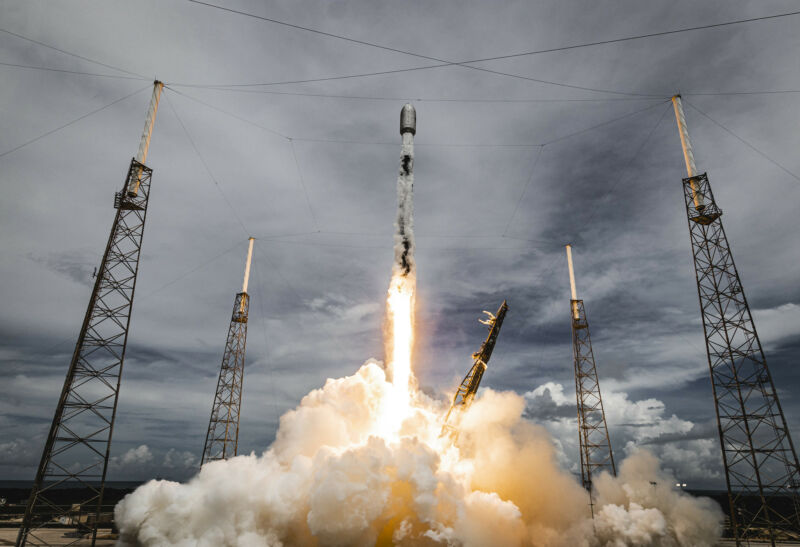A Virginia company has connected mobile phones directly to satellites

SpaceX
A space startup says it has successfully demonstrated the ability to use ordinary, unmodified mobile telephones to connect to satellite Internet services.
The Virginia-based company, Lynk, sent its “Shannon” satellite into orbit three months ago as part of a rideshare mission on a Falcon 9 rocket. After some initial tests, the company said “hundreds” of mobile phones in the United States, United Kingdom, and the Bahamas were able to connect with the satellite as it passed overhead, as if it were a virtual cell phone tower in space.
“Basically, our satellite looks to your cell phone like a standard cell tower,” said Charles Miller, the co-founder and chief executive of Lynk.
Satellite Internet is all the rage in the space and telecommunications industry, with companies such as SpaceX, OneWeb, Amazon, Telesat, and more launching or planning large constellations of satellites to deliver broadband Internet. But all of these services will require a terminal of sorts, perhaps akin to a DirecTV satellite dish, to send and receive signals to low Earth orbit.
The difference with Lynk, Miller says, is that with its 1 m × 1 m satellite there is no terminal needed, nor even software to download. The service is intended to serve remote areas where a customer’s mobile provider, such as T-Mobile or Verizon in the United States, does not have coverage. So like when you travel to a foreign country and are asked whether you want to use a local service with international roaming charges, a similar message would pop up when exiting a mobile provider’s coverage area. Lynk, in this way, shares spectrum with the mobile network operator.
Technical challenges
To make it all work, Lynk had to solve a number of technical problems, Miller said. Chief among these was being able to send uplink signals from a mobile phone to a satellite through the “noise” of other phones. Another challenge was compensating for the huge amount of doppler shift between the satellite and mobile phone on the ground. Existing phones and mobile networks are set up to accommodate bullet train speeds but not orbital velocities. Lynk engineers had to devise the technology for the satellite to perform this doppler compensation in space so that the phone “sees” what appears to be a fixed tower.
Lynk is starting small. With a single satellite, coverage is only available for a few minutes daily, across several degrees of latitude. With 10 satellites next year at an altitude of about 500 km, Miller said, the goal is to have coverage for much of the planet every several hours. By 2023, with about 100 satellites, there would be coverage every 5 to 20 minutes. To build a continuous, real-time network will require 1,500 satellites, he said.
“When people are presented with having nothing, or a satellite every 15 minutes, we are much better than nothing,” Miller said. “It’s a life-saving technology.”
With limited bandwidth, initially the service will offer text messages only—focusing on the life-saving potential for users in the aftermath of a hurricane or lost on a mountaineering expedition or at sea. But eventually there will be enough satellites to serve broadband Internet, Miller said. Prices for the service will be set by the mobile network operator.
So far the company has raised $20 million but still has much of that in the bank. According to Lynk’s research, the average mobile phone in use today on Earth is only connected to a terrestrial network about 85 percent of the time. So as many as 750 million people are experiencing disconnectivity at a given time. That’s the market Lynk intends to serve. So far the company has reached carrier agreements with Aliv in the Bahamas and Telecel Centrafrique in the Central African Republic.
A competitor
Lynk is not the only company working to directly connect terrestrial phones with satellites. A Texas-based company, AST SpaceMobile, launched a small test satellite called BlueWalker 1 in 2019, validating its satellite-to-cellular architecture. The spacecraft successfully managed communications delays from low Earth orbit and the effects of doppler in a satellite-to-ground cellular environment using the 4G-LTE protocol, the company said.
AST’s next prototype spacecraft, BlueWalker 3, is expected to launch aboard a SpaceX mission from Cape Canaveral, Florida, as early as March 2022. The spacecraft has an aperture of 64 square meters and is designed to communicate directly with cell phones via 3GPP standard frequencies.
The company has entered into agreements and understandings with mobile network operators that collectively cover approximately 1.5 billion mobile subscribers. Partners in this effort are leading global wireless infrastructure companies that include Vodafone, Rakuten, and American Tower.
However, AST has yet to obtain permission from the Federal Communications Commission for access to the US market. Previously, NASA has raised concerns about the large size of the proposed satellites, with a hard-body radius of 30 meters and a much larger antenna array. The matter remains pending.








